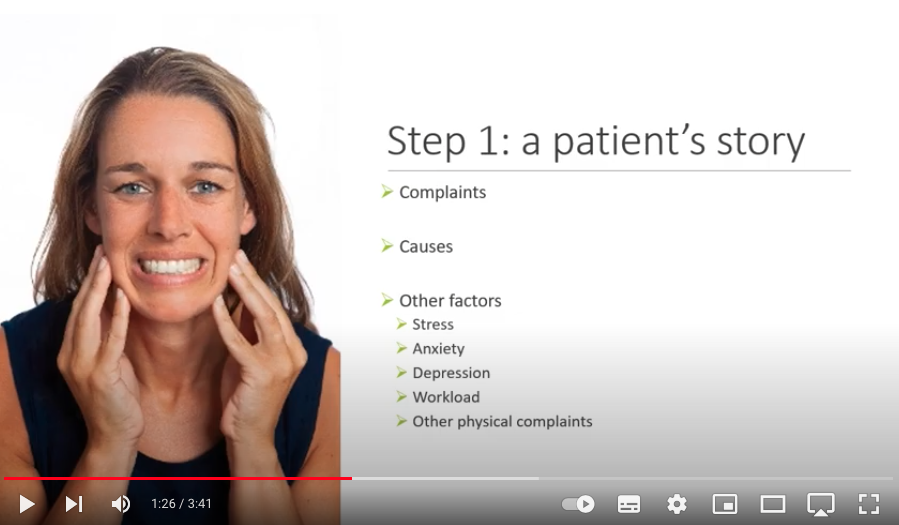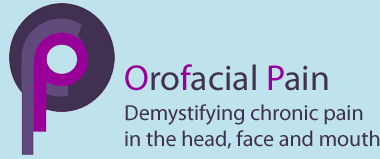Persistent Idiopathic Facial Pain
Otherwise known as Atypical Facial Pain (AFP, atypical facial neuralgia, chronic idiopathic facial pain or psychogenic facial pain, is a type of chronic facial pain which does not fulfill any other diagnosis.
This condition relates to pain in the face and mouth that does not fit the classic presentation of other known conditions. The pain is constant, mid high level, has often been present for many years, it has resisted many forms of medical and or surgical intervention. It is described as a moderate to severe ache or burning sensation that usually affects several areas of the face and mouth that do not conform to the neural distribution of the trigeminal nerve. Upon examination and workup, no abnormality is noted.
Within the group of chronic facial pain syndromes, PIFP represents a particular diagnostic challenge. Patients frequently have multiple investigations and multiple diagnoses. As with all patients with pain assessment a holistic approach and a multidisciplinary approach is required to address the many facets of this pain syndrome.
A suggested patient pathway for treatment and recent update is available online.
Classification
There is no consensus as to a globally accepted definition, and there is even controversy as to whether the term should be continued to be used. Both the International Headache Society (IHS) and the International Association for the Study of Pain (IASP) have adopted the term persistent idiopathic facial pain (PIFP) to replace AFP. In the 2nd Edition of the International Classification of Headache Disorders (ICHD-2), PIFP is defined as “persistent facial pain that does not have the characteristics of the cranial neuralgias and is not attributed to another disorder.” (LINK to classification of OFP domain)
Intraoral persistent idiopathic pain
Otherwise known as Atypical odontalgia, persistent dentoalveolar pain (PDAP), phantom tooth pain, psychogenic toothache. However, the term AFP continues to be used by the World Health Organization‘s 10th revision of the International Statistical Classification of Diseases and Related Health Problems and remains in general use by clinicians to refer to chronic facial pain that does not meet any diagnostic criteria and does not respond to most treatments. A specific screening tool has been developed for this condition.
Similar to extra oral PIFP the main features of intraoral PIFP are: no objective signs, negative results with all investigations/ tests, no obvious explanation for the cause of the pain, and a poor response to attempted treatments.[6] AFP has been described variably as a medically unexplained symptom, a diagnosis of exclusion, a psychogenic cause of pain (e.g. a manifestation of somatoform disorder), and as a neuropathy. AFP is usually burning and continuous in nature, and may last for many years. Depression and anxiety are often associated with AFP, which are either described as a contributing cause of the pain, or the emotional consequences of suffering with unrelieved, chronic pain. For unknown reasons, AFP is significantly more common in middle aged or elderly people, and in females.
From Pt.co.uk information on Facial pain
Facial pain has a long list of possible causes but the diagnosis can often be made by a good history and examination. The common causes are often benign and self-limiting but it is essential not to miss those conditions that require urgent treatment – eg, temporal arteritis, or early diagnosis – eg, malignancy. There is a tendency to overdiagnose bacterial sinusitis when the real cause may be a viral upper respiratory tract infection or, much less frequently, a more serious cause of facial pain.
Causes[1]
- Sinus: sinusitis, trauma, carcinoma.
- Nose: upper respiratory tract infection, nasal injury and foreign bodies.
- Ear: otitis media, otitis externa.
- Mastoid: mastoiditis.
- Teeth: dental abscess.
- Local soft tissue infection: cellulitis, erysipelas.
- Neurological: trigeminal neuralgia, herpes zoster.
- Parotid gland: mumps, other causes of parotitis, abscess, duct obstruction, calculi, tumour.
- Eye: orbital cellulitis, glaucoma.
- Temporomandibular joint dysfunction and pain.
- Cluster headaches, migraine.
- Temporal arteritis.
- Tumours: nasopharyngeal, oral, posterior fossa, brainstem gliomas.
- Bone: maxillary or mandibular osteitis, cyst.
- Atypical facial pain: more common in the elderly and in women; often linked with depression.
- Lung cancer(upper lobe).[2]
PatientPlus
Presentation[3]
Symptoms
- Site:
- Pain in the region of the ear may be referred from the skin, teeth, tonsils, pharynx, larynx or neck.
- Tenderness over the maxilla may be due to sinusitis, dental abscess or carcinoma.
- Character:
- Trigeminal neuralgia: intermittent sharp, severe pain in the distribution of the divisions of the trigeminal nerve.
- Infections of teeth, mastoid and ear: often dull, aching quality.
- Precipitating factors:
- Precipitated by food or chewing: dental abscess, salivary gland disorder, temporomandibular joint disorder or jaw claudication due to temporal arteritis.
- Trigeminal neuralgia: even the slightest touch of the skin causes intense pain.
- Associated symptoms:
- Obstruction of the lacrimal duct by nasopharyngeal carcinoma may cause watering of the eyes.
- Otorrhoea and/or hearing loss suggest an ear or mastoid cause.
- Nasal obstruction and rhinorrhoea may be due to maxillary sinusitis or carcinoma of the maxillary antrum. Carcinoma of the maxillary antrum may also present with unilateral epistaxis.
- Proximal muscle weakness and pain may be due to polymyalgia rheumatica, associated with temporal arteritis.
Signs
- Unilateral erythema and vesicles in the distribution of the trigeminal nerve: herpes zoster infection (may not be present in the early stages of the disease).
- Localised erythema or swelling: localised infection or carcinoma.
- Inspection of the nose and throat may demonstrate a nasopharyngeal tumour.
- Facial palsy: may be due to a tumour of the parotid gland.
- Tenderness of the superficial temporal artery associated with temporal arteritis.
- Cervical lymphadenopathy: infection or carcinoma.
Investigations
- FBC: raised white cell count in infection or malignancy.
- ESR, CRP: increase in infection, malignancy, temporal arteritis.
- X-rays:
- Opacification of the sinus and destruction of bone with carcinoma of sinuses.
- Opacification may also occur in sinusitis.
- Mastoid films may show opacification in cases of mastoiditis.
- MRI scan with and without gadolinium is the investigation of choice. CT scan with contrast is less useful because there is less resolution of the cranial nerves and posterior fossa. .[1]
- Sialography: parotid conditions – eg, duct stones, sialectasis.
- Fine needle aspiration: parotid tumours.
Management
- The essential aspect of management in primary care is to make an accurate diagnosis. The management will then depend on the identified cause of facial pain.
- The first-line treatment for atypical facial pain is a tricyclic antidepressant such as amitriptyline. Fluoxetine and venlafaxine can also been considered.[4]Peripheral subcutaneous field stimulation may be an alternative for patients with intractable pain.[5]
- Specialist referral should be made according to local guidelines. One such guideline suggests referring patients who have:[6]
- Facial pain persisting for more than three months.
- Persistent temporomandibular disorders not responding to simple analgesics, lifestyle changes and reassurance.
- Persisting pain affecting function and causing distress.
- Widespread pain.
- Pain which is part of systemic disease.
- Significant psychological or social problems.
- Co-existing mental health problems which have an impact on treatment.
- Compliance problems – eg, side-effects.
- A recognised pain syndrome such as trigeminal neuralgia.
- Patients with special needs – eg, learning disabled, communication problems.
Further reading & references
- Aggarwal VR, Macfarlane GJ, Farragher TM, et al; Risk factors for onset of chronic oro-facial pain–results of the North Cheshire oro-facial pain prospective population study. Pain. 2010 May;149(2):354-9. Epub 2010 Mar 20.
- Krolczyk SJ; Persistent Idiopathic Facial Pain, Medscape, Mar 2012
- Ruffatti S, Zanchin G, Maggioni F; A case of intractable facial pain secondary to metastatic lung cancer. Neurol Sci. 2008 Apr;29(2):117-9. Epub 2008 May 16.
- Raval T et al; Facial Pain and Headache, Medscape, Nov 2011
- Cornelissen P, van Kleef M, Mekhail N, et al; Evidence-based interventional pain medicine according to clinical diagnoses. 3. Persistent idiopathic facial pain. Pain Pract. 2009 Nov-Dec;9(6):443-8.
- Yakovlev AE, Resch BE; Treatment of chronic intractable atypical facial pain using peripheral subcutaneous field stimulation. Neuromodulation. 2010 Apr;13(2):137-40. doi: 10.1111/j.1525-1403.2009.00249.x. Epub 2010 Jan 12.
- How to refer – Facial pain, University College London Hospitals (links to Word document)
Disclaimer: This article is for information only and should not be used for the diagnosis or treatment of medical conditions. EMIS has used all reasonable care in compiling the information but make no warranty as to its accuracy. Consult a doctor or other health care professional for diagnosis and treatment of medical conditions. For details see our conditions.
| Original Author: Dr Colin Tidy |
Current Version: Dr Laurence Knott |
Peer Reviewer: Prof Cathy Jackson |
| Document ID: 2129 (v23) |
Last Checked: 02/11/2012 |
Next Review: 01/11/2017 |
Education menu

Physiotherapy for Orofacial Pain
A short introductory presentation by Dr Hedvig van der Meer who has recently joined our team:

Our guide to better sleep
By Georgina Gray Good quality sleep is one of our core health pillars. Not only is it vital for energy, mental health and hormone production, it is also important for disease prevention and weight control. We should be aiming for 7-9 hours of good quality sleep every...

